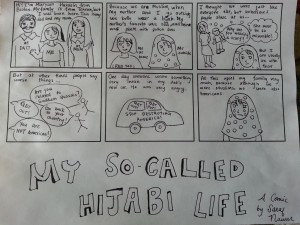The Hijabi Life: Creative Response for Week 12
Medium: comic (pen/ink on paper)
This week, reading Persepolis by Marjane Satrap, I was highly captivated by just how effective a medium such as a graphic novel could be in conveying an emotionally and politically charged story. I have to admit, part of the reason I was especially enthralled by this piece was because I was a great fan of graphic novels growing up (especially of manga). However, what made Persepolis special was the way in which it portrayed the many ways that the Iranian Revolution affected the lives of those living in Iran, especially that of women. In class this week, the role of women in Islam has been discussed extensively, and in particular, the idea that often, the attitudes toward women in Islamic countries is comes not always from religious ideals, but from cultural practices. Clearly, the Iranian Revolution had a tremendous impact on women, as the previously ‘Western’ Iranian society was shunned, and a turn to a more conservative interpretation of Islam was embraced.
For this week’s creative response, I thus decided to use comic strip to convey today’s notions of Islam, particularly in western countries, such as the U.S. Thus, following the style of Satrap’s Persepolis (both her style of drawing and characterization), I decided to create a fictional character named Maryam Hussain from Iran living in Boston, MA. The storyline I wanted to convey is that of a young girl coming from a Muslim country who is at heart “American” but because she and her mother wears a hijab, they are often seen as outsiders by many people. Obviously, the events portrayed in this comic strip are fictional, but I’m sure similar situations apply to many Muslim families in America where the women wear hijabs, and as such, when they live in communities where the Muslim population is sparse, they are often treated as outsiders. I felt that this connected well with the reading for this week, in that whereas wearing a hijab in Iranian society in the aftermath of the Iranian Revolution was a way to blend in (and not suffer the consequences), wearing a hijab in many ways can lead to the opposite scenario in western countries, since those donning a hijab are considered to be anti-Western, and hence, has the opposite of making one ‘blend in.’
References:
Persepolis by Marjane Satrap
